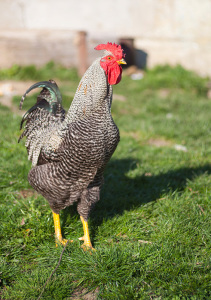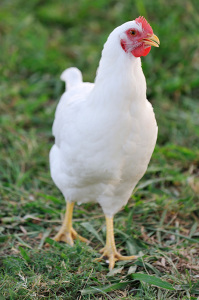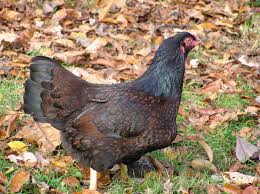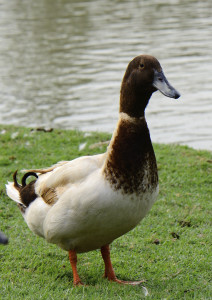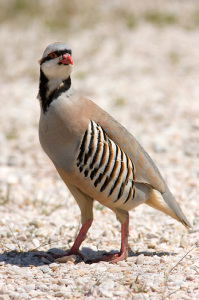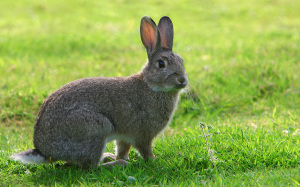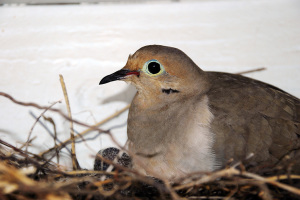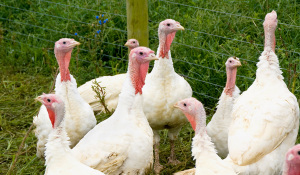Red Pullets and Broilers
Broiler chickens (Gallus gallus domesticus) are a domesticated fowl, a subspecies of the Red Junglefowl, bred and raised specifically for meat production. Chickens are one of the most common and widespread domestic animals, and with a population of 19 billion in 2011, there are more chickens in the world than any other species of bird. Typical broilers have white feathers and yellowish skin. Most commercial broilers bred for meat reach slaughter weight at between 5 to 7 weeks of age, although slower growing strains reach slaughter weight at approximately 14 weeks of age. Because of this young age, much of their behaviour and physiology is that of an immature bird. Broilers and egg laying hen are the same species and share many characteristics, however, due to the rapid growth and selection for enlarged breast muscles, broilers are susceptible to different welfare concerns, particularly skeletal malformation and dysfunction. Broilers are usually grown as mixed-sex flocks in large sheds under intensive conditions, but some strains can be grown as free-range flocks.
Gray Pullets and Broilers
The California Gray is an American breed of domestic chicken bred in the U.S. The objective of the breed is to produce a dual-purpose chicken that is both suitable for meat and egg production. This breeds produces large white eggs. It is a cross between Barred Plymouth Rock rooster and a White Leghorn hen. The males of the species are around 5.5lb. and females are 4.4lb.
White Pullets and Broilers
Typical broilers have white feathers and yellowish skin. The gene for yellow skin was introduced into domestic birds through hybridization with the grey junglefowl (G. sonneratii). Modern crosses are best for meat production because they lack the typical hair which many breeds have that necessitates singeing after plucking. Both male and female broilers are reared for their meat. Most commercial broilers reach slaughter-weight at around five to seven weeks of age but slower growing breeds reach slaughter-weight approximately at 14 weeks of age. Females over a year old are known as hens and younger females as pullets although in the egg-laying industry, a pullet becomes a hen when she begins to lay eggs at 16 to 24 weeks of age. Broiler chickens are farmed for meat and usually live till 6 years of age but reach consumption age at 6 weeks.
Poussins
In the US Poussin is an alternative name for a small-sized cross-breed chicken called Rock Cornish game hen, developed in the late 1950s, which is twice as old and twice as large as the typical British poussin. Poussin, also known as coquelet or spring chick, is a young chicken less than 28 days old and usually weighs 14–16 oz but not above 26 oz. Although, spring chicken usually refers to chickens weighing 26–30 oz. The meat is very tender and lean.
Cornish Game Hens
In the United States, a Cornish game hen, also sometimes called a Cornish hen, poussin, Rock Cornish hen, or simply Rock Cornish, is a hybrid chicken. Cornish Game hen is a a young immature chicken that is less than five weeks of age and weighing no more than two pounds ready-to-cook. Cornish Game Hen also has shorter growing span of only 28 to 30 days. It is not a game bird but a broiler chicken and the most common strain of commercially raised meat chickens. Though the bird is called a “hen”, it can be either male or female.
Silkies
The Silkie is a breed of chicken named for its plumage which has a silky feel to it. The breed has black skin and bones, blue earlobes, grayish-black meat and five toes on each foot unlike most chickens who only have four. Standard Silkies are relatively small chickens, with the males weighing only 4lb. and the females weighing 3lb. Silkies are also well known for their calm and friendly temperament; one of the more docile of poultry. Hens are also exceptionally broody.
There are two distinct varieties of Silkies: Bearded and Non-bearded. Bearded Silkies also have a muff of feathers under the beak area that covers their earlobes. They are also come in different colors: Black, Blue, Buff, Grey, Partridge, White as well as less common color like Cuckoo, Lavender, Red, and Splash.
Muscovy Ducks
The Muscovy duck (Cairina moschata) is a large duck native to Mexico, Central, and South America. They are a large duck, with the males about 30 in long, and weighing up to 15 lb. Females are considerably smaller, and only grow to 6.6 lb. The bird is predominantly black and white, with the back feathers iridescent and glossy in males, while the females are more subdued. The amount of white on the neck and head is variable, as well as the bill, which can be yellow, pink, black, or a mixture of these. They may have white patches or bars on the wings, which become more noticeable during flight. Both sexes have pink or red wattles around the bill, the male wattle is larger and more brightly colored.
Khaki Campbell Ducks
The Khaki Campbell Duck is a domesticated breed of ducks that originated in England and is known for its high egg production. The breed was developed by Mrs. Adel Campbell at the turn of the 20th century. The “Campbell Duck” was first introduced in 1898 and with further refined crossbreeding produced the ‘Khaki’ variety that was introduced in 1901. Khaki Campbell is a cross between Mallard, Rouen and Runner ducks. The Khaki Campbell Ducks reach maturity at approximately 7 months and at adulthood Campbells weigh approximately 3-5 pounds. They come in three color varieties: khaki, dark and white. The Khaki Campbell adult male is mostly khaki colored with a darker head, usually olive green, without the white ring of its Mallard ancestry. The egg production of the Campbell breed can even exceed the best domestic chickens, with the breed being able to lay an average of 325 eggs a year.
Chukars
The Chukar partridge or Chukar (Alectoris chukar) is in the pheasant family Phasianidae. The Chukar got its name from the noise they make that sounds chuck-chuck-chukar-chukar. The Chukar is a roundish 13”–14” long partridge with a light brown back, grey breast, and buff belly. Their face is white with a black gorget, rufous-streaked flanks, red legs and coral red bill. The shades do vary across different populations of the bird. The sexes, however, are similar, the female slightly smaller in size and lacking the spur. Other names for this bird include chukker (chuker or chukor), Indian chukar and keklik.
The Chukar partridge has its native range in Asia, including Israel, Lebanon, Turkey, Iran, Afghanistan, Pakistan and India as well as the inner ranges of the Western Himalayas to Nepal. The species that were brought to US were from populations collected from Afghanistan and Nepal.
Guinea Hens
The Numididae Guineafowl sometimes called “original fowl” or Guineahen are a family of birds in the Galliformes order. The Guineafowl are native to Africa and one of the oldest of gallinaceous birds. They are phylogenetically between Peafowl and the Odontophoridae. This family of birds is insect and seed-eating, ground-nesting and resemble partridges but with featherless heads, though both members of the genus, Guttera have a distinctive black crest. These large birds measure from 16–28 in. in length, and weigh 1.5-3.5 lb. All Guineafowl are social and usually live either in small groups or large flocks. Guineafowl meat is dryer and leaner than chicken meat with a gamey flavor. It is slightly more protein rich than chicken or turkey with half the fat of chicken and with fewer calories. However, Guineafowl eggs are richer than chicken eggs.
Red Fowl
The Red Junglefowl (Gallus gallus) is a tropical member of the Phasianidae family.
The Red Junglefowl is believed to be the ancestor of the domestic chicken, with some hybridization with the Grey Junglefowl. The Red Junglefowl was first domesticated around five thousand years ago in Asia and then spread across the world. The domestic form is kept as a very good food source of both meat and eggs. The males of the species are much larger with red fleshy wattles and comb on the head and are brightly colored while the female are much smaller with a subdued plumage for camouflage as she is the one that looks after the eggs and chicks. Male Red Junglefowl have a shorter crowing sound than domestic roosters. They are omnivorous and feed on insects, seeds and fruits. Flight for these birds is confined to short distances and high enough only to reach their roosting areas in trees or get away from ground predators.
Rabbits
Rabbits are small mammals in the Leporidae family of the order Lagomorpha, found in several parts of the world. The male is called a buck and the female is a doe; a young rabbit is a kitten or kit. More than half the world’s rabbit population resides in North America. Their size can range anywhere from 8” to 20” in length and weigh more than 4lb. The fur is most commonly long and soft, with color variations of brown, gray, and buff. Rabbits can see nearly 360 degrees, with a small blind spot at the bridge of the nose. Rabbits are herbivores that feed by grazing on grass, forbs, and leafy weeds. The only rabbit to be widely domesticated is the European rabbit. Domesticated rabbits have mostly been bred to be much larger than wild rabbits, selective breeding has produced a range sizes from “dwarf” to “giant. Rabbits can turn 20 percent of the proteins they eat into edible meat, compared to 22 to 23 percent for broiler chickens, 16 to 18 percent for pigs and 8 to 12 percent for beef; rabbit meat is more economical in terms of feed energy than beef. Rabbit meat is richer in proteins but low in fat.
Squab
Squab is a young domestic pigeon, typically under four weeks old. Pigeons bred for meat are generally called squab and are harvested from young birds, mostly utility pigeons. Pigeons grow to a very large size in the nest before they are fledged and able to fly and in this stage of their development they are called squabs and are prized as food. The meat is close in taste to dark chicken meat. Squabs are raised until they are roughly a month old, that is when they reach adult size but have not yet flown, and that is when they are best for consumption. Usually considered a delicacy, squab is tender, moist and richer in taste than many commonly consumed poultry meats, but there is relatively little meat per bird, the meat being concentrated in the breast. Squab is dark meat, and the skin is fatty resembling that of a duck. The meat is very lean, easily digestible, and “rich in proteins, minerals, and vitamins”. It has been described as having a “silky” texture, as it is very tender and fine-grained. It has a milder taste than other game, and has been described as having a mild berry flavor.
Quail
Quail is a collective name for 130 species of small short tailed game birds placed in the order Galliformes. Old World quail is found in the pheasant (Phasianidae) family and New World quail is found in the family Odontophoridae. Old World quail are smaller plain birds, shorter and stockier than their New World counterparts. Quail come in many different species from all different parts of the world. Quails are mostly small birds but many of the common larger species are farm-raised for food and egg consumption. Quails are omnivorous animals, they tend to have a mostly vegetarian diet consisting of seeds, grain, and fruit but they will also eat insects. Quail meat and eggs are considered a delicacy in many parts of the world.
Turkey
The Turkey is a large bird in the genus Meleagris gallopavo, which is native to the Americas. One species, Meleagris gallopavo commonly known as the domestic turkey or wild turkey, is native to the forests of North America, mainly Mexico and the United States. Males of the species have a distinctive fleshy wattle called a snood. As in many galliformes, the male is larger and more colorful than the female. Turkeys are in the family of Phasianidae (pheasants, partridges, francolins, junglefowl, grouse…). Europeans first encountered turkeys in America and they incorrectly identified the birds as a type of guineafowl that is a members of a group of birds which were thought to typically come from the country of Turkey. The name of the North American bird became “turkey fowl” and later shortened to “turkey”. The wild male turkey is roughly 50in. long and weighs about 22lb, though average weigh less. The female turkeys weigh only half as much as the males. Domesticated strains can be much heavier.


